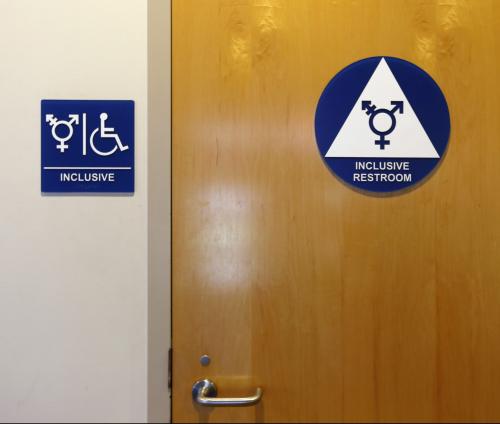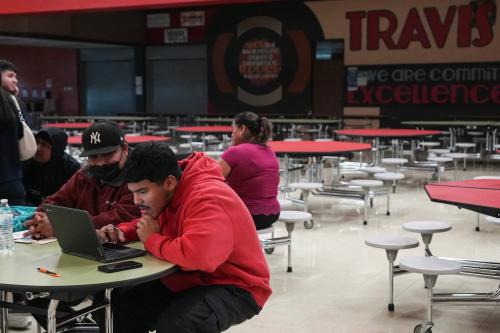On June 23, 1972, President Nixon signed the Education Amendments Act of 1972. Title IX of the Act has become one of the most important, yet contested, federal protections of students’ civil rights and educational opportunities. It reads:
No person in the United States shall, on the basis of sex, be excluded from participation in, be denied the benefits of, or be subjected to discrimination under any education program or activity receiving Federal financial assistance.
On June 23, 2022, the U.S. Department of Education released its proposed changes to Title IX regulations for public comment. The Biden administration says the changes would restore protections from sexual harassment and assault, as well as sex-based discrimination, including for LGBTQI+ students who confront discrimination based on their sexual orientation or gender identity. Its proposed amendments would reverse many changes made by the Trump administration.
Over the next several months, the Department will collect and review public comments on its proposed amendments before issuing its final regulations. In the meantime, the Brown Center on Education Policy invited three experts of Title IX and education law to share their reactions and expectations
Question 1: What elements of Title IX are you paying close attention to as these new proposed rules enter the negotiated rulemaking process?
Kimberly J. Robinson:
I am paying especially close attention to two issues.
First, the burden of proof to establish that sex discrimination occurred is what determines the effectiveness of Title IX, particularly in instances of sexual harassment and assault. The proposed regulation generally requires a recipient to adopt a preponderance of the evidence standard, i.e., to prove that more likely than not discrimination occurred. The prior regulation (from the Trump administration) required a recipient to adopt the same standard of proof as it adopts for complaints against employees, including faculty, which typically is a clear and convincing evidence standard. The latter standard is so difficult to meet that it can deter those who have experienced sexual harassment and assault from coming forward. The preponderance of the evidence standard appropriately enables the decisionmaker to weigh all available evidence, including the credibility of witnesses, and determine what is likely to have happened without extrinsic corroborating evidence that is oftentimes lacking.
Another critical issue is whether cross examination at a live hearing is mandatory. The proposed regulations give educational institutions flexibility to assess credibility through questioning at individual meetings with the parties or a live hearing. The proposed rule will enable institutions to continue to assess the credibility of witnesses while also tailoring the proceedings to the nature of the allegations and the impact of the proceedings on the complainant and the accused. This approach is cost effective and eliminates the adverse effects that mandatory live hearings can impose upon both parties.
Shep Melnick:
Responding to charges that the Department’s Obama-era policies had denied due process and free speech rights to students accused of sexual misconduct, the Trump administration issued regulations that narrowed the definition of sexual harassment, required colleges to hold live hearings with cross-examination of witnesses, and prohibited them from using a “single investigator model” for resolving sexual misconduct cases.
The Biden administration’s proposal does just the opposite: it broadens the definition, eliminates the live hearing and cross-examination requirements, and allows the same person who investigates sexual misconduct complaints to determine guilt and innocence. These are the most controversial elements of the proposal, but there are many more. Other provisions spell out who must report misconduct, how far the responsibilities of schools extend, what triggers an investigation, the burden of proof, and much more.
Since this was only a proposal—with key parts labelled “tentative”—it will be months before we see the final regulations, and much longer before we know if they can survive judicial review.
Suzanne Eckes:
I am paying most attention to how the proposed rules have addressed discrimination related to sexual orientation and gender identity under Title IX. The U.S. Supreme Court has not yet addressed this issue under Title IX. In 2020, the Court ruled in Bostock v. Clayton County that an employer who fires someone for being gay or transgender violates Title VII of the Civil Rights Act of 1964. Although the Bostock opinion addresses employment matters, courts examining Title IX issues often look to Title VII cases for guidance. For example, when the Fourth Circuit ruled in favor of a transgender student based on equal protection and Title IX claims, the circuit observed that “after the Supreme Court’s recent decision in Bostock . . ., we have little difficulty holding that a bathroom policy precluding Grimm from using boys’ restrooms discriminated against him ‘on the basis of sex.’”
Question 2: How will these changes impact students, schools, and other stakeholders? Who benefits?
Kimberly J. Robinson:
The proposed regulation would expand the obligation of educational institutions to take action to remedy sexual harassment because it defines prohibited hostile environment harassment as “unwelcome sex-based conduct that is sufficiently severe or pervasive, that, based on the totality of the circumstances and evaluated subjectively and objectively, denies or limits a person’s ability to participate in or benefit from the recipient’s education program or activity” (emphasis added). Students will receive greater protection from unwelcome sexual misconduct without having to show that the behavior is “so severe, pervasive, and objectively offensive” that it denied access to education, as the prior regulation required. All students will benefit from a stronger institutional commitment to preventing, ending, and remedying a broader range of sexual harassment so that students can focus on learning in a safer and more welcoming environment.
The proposed revisions also confirm the applicability of Title IX’s protections to all forms of sex discrimination, including discrimination based on sexual orientation and gender identity, consistent with Supreme Court precedent. Creating an inclusive educational environment requires that all students have a remedy for discrimination. However, the benefits of defining Title IX to include all forms of sex discrimination extends not only to students who experience discrimination based on sexual orientation and gender identity but also to the country because more inclusive educational environments lay the foundation for a more inclusive nation.
Shep Melnick:
With three major revisions to Title IX’s sexual harassment protections in a decade, this has been a trying time for school officials tasked with Title IX compliance. The 2020 rules stayed close to the Supreme Court’s interpretation of Title IX; the current proposal sweeps much more broadly. Predicting whether the Court will eventually accept this more expansive interpretation is risky business.
In the meantime, colleges must ponder whether to dispense with live hearings and cross-examination. The proposal leaves it up to schools to fashion procedures that “adequately assess the reliability of witnesses.” As the Department points out, some courts have ruled that live hearings and cross-examination are essential for making such assessments; other courts have disagreed. Schools that instituted live hearings and cross-examination in response to the 2020 rules are sitting in what lawyers call a “safe harbor.” Abandoning this position will invite lawsuits by those found responsible for sexual misconduct. No matter what the Biden administration decides in its final Title IX regulations, many schools will be reluctant to sail out of this “safe harbor” into a sea of judicial uncertainty.
Suzanne Eckes:
Title IX changes will impact transgender students’ schooling experiences and help school districts develop policies that do not perpetuate discriminatory practices. Numerous studies have found that when schools treat LGBTQ+ students with dignity, it fosters a feeling of safety and improves students’ overall well-being.
Several state and federal courts have examined cases involving discriminatory practices in schools directed toward transgender students, which seem to align with the proposed Title IX rules. There have been at least a dozen federal or state court cases initiated by transgender students who have alleged violations under the Equal Protection Clause of the Fourteenth Amendment, Title IX of the Education Amendments of 1972, or state law when they have not been permitted to use a preferred restroom in school. Nearly all of these cases have ended in a favorable result for the transgender student. Likewise, there have been at least five federal court cases initiated by cisgender students who have claimed their right to privacy is violated when they are required to share a restroom with a transgender student at school. In these decisions, courts have found no right to privacy. The proposed rule seems to align with these earlier court decisions.
Question 3: Title IX rules and enforcement have changed markedly across recent presidential administrations. Is this something the public should be concerned about moving forward?
Kimberly J. Robinson:
Many of the changes to Title IX rules and enforcement reflect progress in extending its protections to forms of sex discrimination that too often went unrecognized, unreported, or unaddressed. However, one administration’s progress can be defined as another administration’s retrenchment. Setting aside Title IX and athletics (which is not addressed in the proposed regulations), it is essential to recognize that despite ongoing disagreement between presidential administrations, much of the ongoing debate is about how Title IX will address sexual assault and harassment rather than whether Title IX will address it. Although the progress is not linear, this still represents critical progress that is making our schools and colleges safer for all students. Hopefully, the public can find encouragement in that progress even if some disagreement endures.
Shep Melnick:
Why has Title IX regulation become so complicated and controversial? After all, it is hard to find a law that has been so successful in meeting its original purpose. The 1972 law was designed to open educational opportunities to women and girls. Once those doors swung open, female students rushed through, and they now outperform male students in almost all respects.
The source of the controversy, as I describe in The Transformation of Title IX, is the subtle shift in the purpose of regulation from educational opportunity to changing the way all of us think about sex, gender, and sexuality in general. Behind the oscillation of Title IX policy lies a battle between two understandings of its purpose. According to the vision first articulated by the Supreme Court in 1998-99, schools must take action against individual students or employees who engage in sexual misconduct so serious that it deprives specific students of the opportunity to receive an education. The Trump administration’s 2020 regulations followed this relatively narrow understanding, with a focus on spotting and punishing the “bad apples” who engage in serious misconduct.
The 2022 proposal, in contrast, endorses what the Obama administration called a “new paradigm” on sexual harassment, one far removed from the Supreme Court’s interpretation of Title IX. According to this approach, the problem is not a few bad apples but rather a “rape culture,” especially on college campuses. The Biden administration’s focus is changing that culture, as the President frequently emphasizes. This entails a much broader set of actions, from requiring an assortment of trainings to expanding the responsibility of educational institutions.
As federal regulation swings between these competing understandings of Title IX, schools throughout the country struggle to figure out how to comply with conflicting administrative rules and court decisions.
Suzanne Eckes:
Presidential administrations often release their interpretations of federal rules through guidance documents. These documents are not legally enforceable, but they provide helpful information for school officials. The Obama administration used non-binding guidance documents—not regulations—to communicate its interpretation of Title IX’s protections for transgender students. This made it easy for the Trump administration to rescind the guidance.
The Biden administration is pursuing the formal rulemaking process, which would give its interpretation deference in court. The Biden administration’s interpretation of the law, which includes a prohibition on discriminating against someone based on sexual orientation and gender identity, is expected to be formally written into the regulation. If enacted, the U.S. Department of Education’s proposed rule will protect the rights of LGBTQ+ students who simply want to be included in school-related activities.
Some Republican governors and state legislators referenced the Biden administration’s potential Title IX’s protections for transgender students as a motivating factor for legislation attacking transgender female athletes. In fact, a coalition of 20 state attorneys general are suing the U.S. Department of Education to stop it from enforcing its interpretation of Title IX—a lawsuit that is pending in a federal district court. Notably, the proposed rule does not address the athletics issue.









Commentary
Reactions to the Biden administration’s proposed Title IX changes from education law scholars
June 30, 2022